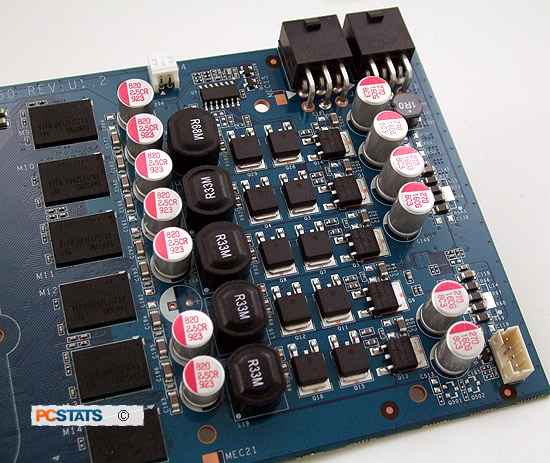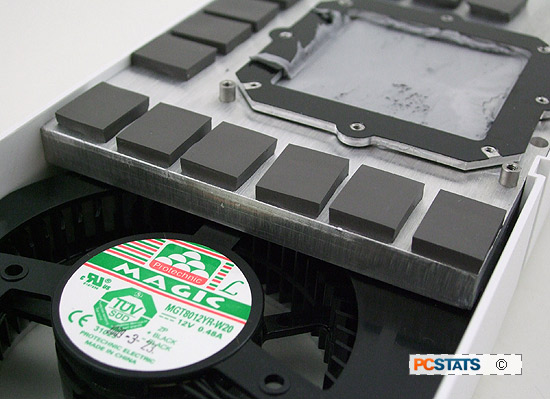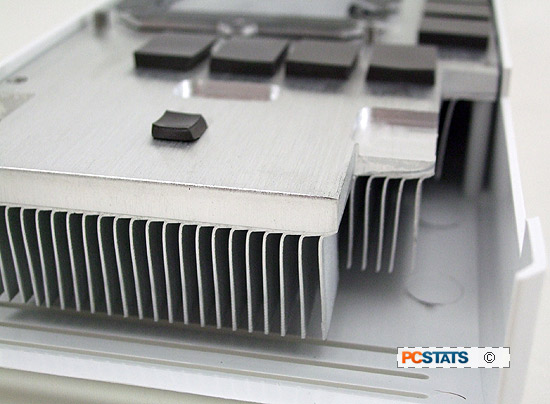
|
The Geforce GX 260 core on
Sparkle's videocard is clocked at the default speed of 576MHz, the shaders hum away at 1242MHz, while the GDDR3
memory runs at an even 999MHz.
81% Rating: 
|
|
|
|
Home >
Reviews >
Video Cards >
Sparkle GTX260 Core 216 |
|
|
Videocard Power Consumption Measurements
Here's
how the Sparkle GTX260 Core 216 videocard stacks up in real life against a
couple different cards. PCSTATS measures total system power draw and compares
that in 3D loaded (max value recorded in 3DMark06) and idle states (at Windows
desktop). The power supply used in each test is an A-PFC compliant PC Power and Cooling 750W model.
 Videocard Power
Consumption (Total System Power Draw) Videocard Power
Consumption (Total System Power Draw) |
| Idle at Desktop |
Watts |
Ranking |
| Palit HD4870 X2 2GB |
177 |
   |
| Asus EAH3870 X2 1GB TOP/G/3DHTI/1G/A |
153 |
   |
| Asus EAH3870 X2 1GB TOP/G/3DHTI/1G/A
(Crossfire) |
222 |
   |
| MSI R3870X2-T2D1G-OC |
165 |
   |
| Asus EAH4890 HTDI/1GD5/A |
137 |
   |
| Asus EAH4850 HTDI/512M |
120 |
   |
| MSI R4830 T2D512-OC (Radeon 4830) |
108 |
   |
| Gigabyte GV-R477D5-512HB |
135 |
   |
| Gigabyte GV-R477D5-512HB Crossfire |
180 |
   |
| Asus EAH4770 HTDI/512MD5/A |
101 |
   |
| Diamond Viper Radeon HD 2900XT CrossFire |
195 |
   |
| Asus EAX1900XTX 2DHTV/512M/A |
160 |
   |
| Asus EAX1950PRO/HTDP/256M/A |
150 |
   |
 Sparkle GTX260 Core
216 Sparkle GTX260 Core
216 |
140 |
   |
| ASUS ENGTS250 DK |
120 |
   |
| ASUS ENGTS250 DK in SLI |
170 |
   |
| Gigabyte GV-N96TSL-1GI |
96 |
   |
| nVidia Geforce 9600GTs in SLI |
166 |
   |
| Asus EN9600GT Top/HTDI/512M |
152 |
   |
| Palit Geforce 9600GT 512 |
151 |
   |
| MSI NX8800GTX-T2D768E |
196 |
   |
| MSI NX7950GX2-T2D1GE |
183 |
   |
| MSI NX7900GTX-T2D512E |
165 |
   |
| Gigabyte GV-NX76T256D-RH |
140 |
   |
| 3D Loaded: |
Watts |
Ranking |
| Palit HD4870 X2 2GB |
421 |
   |
| Asus EAH3870 X2 1GB TOP/G/3DHTI/1G/A |
390 |
   |
| Asus EAH3870 X2 1GB TOP/G/3DHTI/1G/A
(Crossfire) |
610 |
   |
| MSI R3870X2-T2D1G-OC |
330 |
   |
| Asus EAH4890 HTDI/1GD5/A |
225 |
   |
| Asus EAH4850 HTDI/512M |
202 |
   |
| MSI R4830 T2D512-OC (Radeon 4830) |
177 |
   |
| Gigabyte GV-R477D5-512HB |
186 |
   |
| Gigabyte GV-R477D5-512HB Crossfire |
279 |
   |
| Asus EAH4770 HTDI/512MD5/A |
153 |
   |
| Diamond Viper Radeon HD 2900XT CrossFire |
549 |
   |
| Asus EAX1900XTX 2DHTV/512M/A |
333 |
   |
| Asus EAX1950PRO/HTDP/256M/A |
252 |
   |
 Sparkle GTX260 Core
216 Sparkle GTX260 Core
216 |
262 |
   |
| ASUS ENGTS250 DK |
214 |
   |
| ASUS ENGTS250 DK in SLI |
316 |
   |
| Gigabyte GV-N96TSL-1GI |
160 |
   |
| nVidia Geforce 9600GTs in SLI |
313 |
   |
| Asus EN9600GT Top/HTDI/512M |
220 |
   |
| Palit Geforce 9600GT 512 |
221 |
   |
| MSI NX8800GTX-T2D768E |
345 |
   |
| MSI NX7950GX2-T2D1GE |
315 |
   |
| MSI NX7900GTX-T2D512E |
277 |
   |
| Gigabyte GV-NX76T256D-RH |
213 |
   | |
The
computer system with the Sparkle GTX260 Core 216 videocard posts a fairly
moderate idle power draw of 140Watts - given the size of this Geforce GTX260
graphics card, and the dual PCI Express power connectors running into it, we
would have expected a significantly higher power load. nVidia has done good work
to ensure minimal power draw when the system is sitting on the desktop and the
GPU isn't being taxed.
When the
computer is stressed with 3DMark 06, power draw for the Sparkle GTX260 Core 216
videocard increases 110W, bringing the total power consumption a relatively
average 262Watts. Not bad at all, particularly when compared to the power
sucking MSI Geforce 8800GTX videocard of just a few years ago topped out at
345W!

The
majority of spikes in the above power draw chart indicate dual videocard SLI or
Crossfire test situations, modern videocards have become a lot more power
efficient thanks largely to die shrinks and optimization. The Sparkle GTX260
Core 216 videocard itself will require two 6-pin auxiliary SLI power connectors,
but when stressed the total power draw doesn't break 300Watts.
Heat and Noise
Observations
The
Sparkle GTX260 Core 216 videocard is clad in a very substantial skived aluminum
heatsink, hidden behind a white plastic fan shroud that directs airflow along
the cards length. A single squirrel cage fan draws air in at the back of the
card and directs it across the heatsink before it's exhausted at the I/O side
back into the case. For some reason Sparkle have kept to a single slot IO
bracket, even though the GTX260 videocard is indeed two slots wide.
Given the
amount of heat produced by a videocard GPU under load, we would have preferred
to have seen the Sparkle GTX260 videocard equipped with a vented IO slot so hot
air is exhausted outside of the PC chassis.

Because
hot air isn't vented out through the card's I/O panel out of the PC case, that
can mean that while the videocard is kept cool, the overall ambient temperature
of other components inside the computer case will rise. It's a good idea to
ensure your PC case has decent airflow to keep overall fan noise down to a low
level... the hotter things get the faster fans need to spin. At full fan speed
the Sparkle GTX260 doesn't make too much noise thankfully.

Along with the massive slab of Geforce GTX260 GPU, the
single-piece skived aluminum heatsink makes contact with each one of the BGA
DRAM modules via small squares of soft thermal gap filler. Next up PCSTATS
overclocks the Sparkle GTX260 Core 216 videocard!
|
